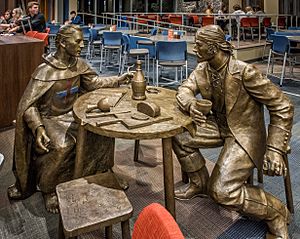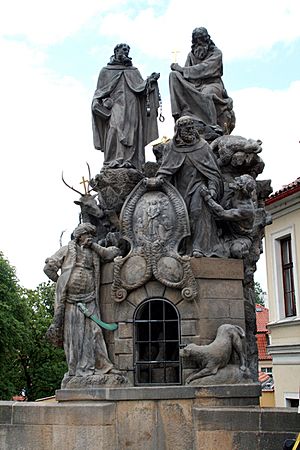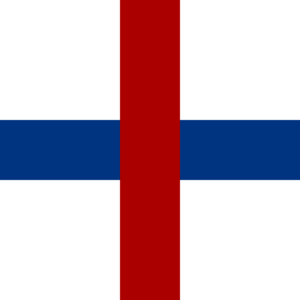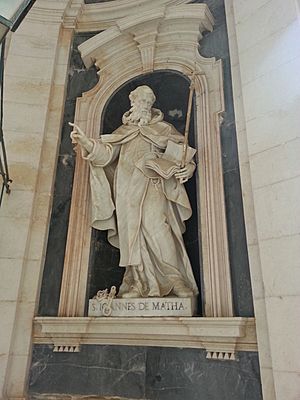John of Matha facts for kids
Quick facts for kids SaintJohn of Matha OSsT |
|
|---|---|

A statue of Saint John of Matha discussing freedom from slavery and sin with a pirate in the University of Mary's Crow's Nest Campus Restaurant.
|
|
| Confessor; Founder of the Trinitarians | |
| Born | 23 June 1160 Faucon-de-Barcelonnette |
| Died | 17 December 1213 (aged 53) Rome |
| Venerated in | Catholic Church |
| Canonized | Cultus confirmed 21 October 1666 by Pope Alexander VII |
| Feast | 17 December (Ordinary Form); 8 February (Extraordinary Form) |
| Attributes | purse, man in Trinitarian habit, with the white with blue and red cross on the breast, with chains in his hands or at his feet, captives near him, and his mitre at his feet |
John of Matha (born 1160, died 1213) was a French Catholic priest. He helped start a special group called the Order of the Most Holy Trinity. Their main job was to free Christians who had been captured by pirates and raiders from North Africa.
Contents
Why People Needed Help
During the Middle Ages, from the 700s to the 1400s, there were many fights between Christian kingdoms in Southern Europe and Muslim groups in North Africa and parts of Europe. People living near the coast, like in Catalonia or Languedoc, were always worried about being captured.
Pirates and raiders would often attack coastal towns. They would kidnap people and make them slaves. Helping to free these captured people was seen as a very good and kind act. Many religious groups started during this time to help rescue Christians who had been taken captive.
John's Early Life and Vision
Most of what we know about John of Matha comes from old stories. We know he was born on June 23, 1169, in Faucon-de-Barcelonnette, France. His parents were Euphemius and Martha.
John's father sent him to Aix-en-Provence to learn important skills for a young nobleman. But John was very kind. He often gave money from his parents to the poor. Every Friday, he visited the hospital to help sick people who had no money.
He later studied religion at the University of Paris. In December 1192, when he was 32, he became a priest.
A Special Vision
According to stories, John had a special vision during his first Mass on January 28, 1193. He saw Jesus holding the hands of two people who were chained. One was a Christian, and the other was a Moor (a Muslim person from North Africa). The Christian had a staff with a red and blue cross.
After this vision, John decided to dedicate his life to freeing Christian captives. He wanted to prepare himself through prayer and quiet time. He heard about a holy hermit named Felix of Valois who lived in a forest. John went to Felix to learn more about living a perfect life.
Starting the Trinitarian Order
One day, while walking with Felix, John had another vision. He saw a white deer with a red and blue cross between its antlers. John told Felix about his plan to help free Christian slaves, and Felix offered to help.
In the winter of 1197, they traveled to Rome to ask the Pope for his approval.
The New Order
On December 17, 1198, Pope Innocent III gave them early approval for a new religious group. This group was named in honor of the Blessed Trinity and focused on freeing Christian captives. The group was fully approved in 1209.
Their first home was in Cerfroid, north of Paris, where Felix used to live. Their second home was in Rome. The Trinitarian Order began rescuing Christian slaves in 1201. John himself traveled to Tunisia in 1202 and 1210, bringing back many Christian slaves.
Before he died, it is said that John of Matha met Francis of Assisi. John died on December 17, 1213, in Rome.
Our Lady of Good Remedy
John started the Trinitarians to visit slave markets. They would buy Christian slaves and set them free in the name of the Holy Trinity. To do this, the Order needed a lot of money.
They asked the Blessed Virgin Mary, the Mother of God, for help with their fundraising. Because she helped them so much, John of Matha gave Mary the special title "Our Lady of Good Remedy." People in Europe and Latin America still honor Mary with this title. Her feast day is celebrated on October 8. Often, pictures of Our Lady of Good Remedy show Mary giving a bag of money to John of Matha.
Honoring Saint John
In 1655, John of Matha's relics (special items connected to him) were moved from Rome to Madrid. He was officially recognized as a saint in 1665. His feast day is December 17 on the current calendar. Some traditional Catholics still celebrate his old feast day on February 8.
His Legacy Today
The Order of the Most Holy Trinity is still active today. They work in many countries across five continents.
DeMatha Catholic High School in Hyattsville, Maryland, US, is named after him. The Trinitarians also support this school.
There is a village in Quebec, Canada, called Saint-Jean-de-Matha.
In 1865, the American poet John Greenleaf Whittier wrote a poem against slavery called "The Mantle of St. John De Matha."
See also
- Felix of Valois
- List of Ministers General of the Trinitarian Order
- In Spanish: Juan de Mata para niños




